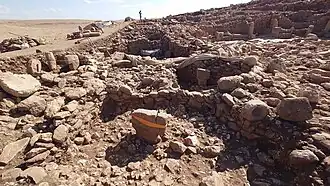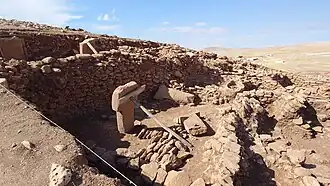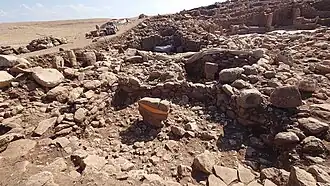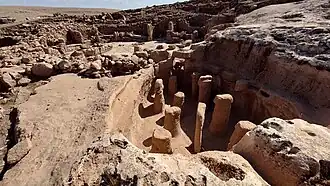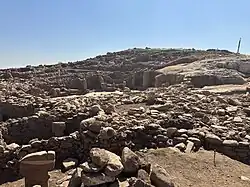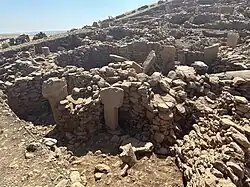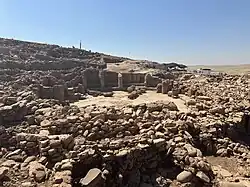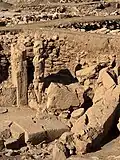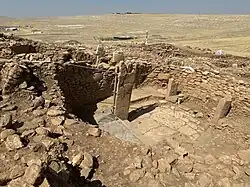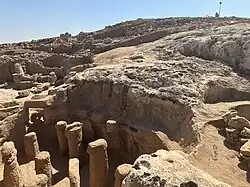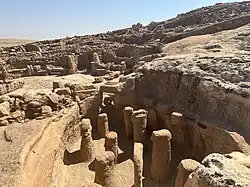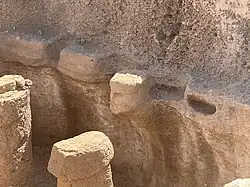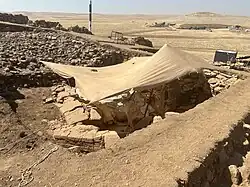Karahan Tepe
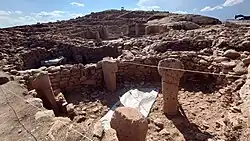 Karahan Tepe in 2023 | |
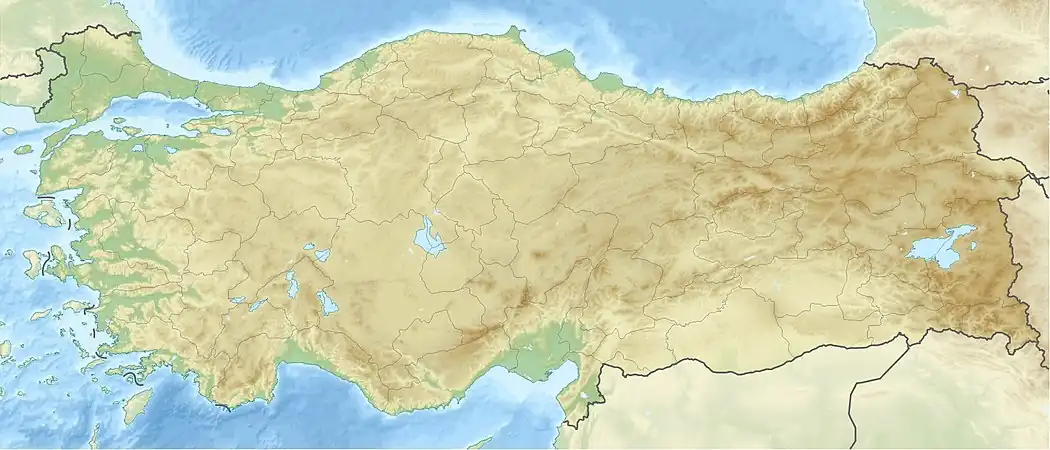 Location in Turkey | |
| Location | Şanlıurfa Province, Turkey |
|---|---|
| Coordinates | 37°05′33″N 39°18′13″E / 37.09250°N 39.30361°E |
| Type | Settlement |
| History | |
| Founded | c. 9750 BCE |
| Periods | Pre-Pottery Neolithic A to B |
| Site notes | |
| Discovered | 1997 |
Karahan Tepe (Kurdish: Girê Keçel) is a Pre-Pottery Neolithic archaeological site in Şanlıurfa, Turkey. The site is in the same geographical region as Göbekli Tepe and archaeologists have also uncovered T-shaped stelae there and believe that the sites are related. Additionally, the site may be the earliest known human village, predating the construction of Göbekli Tepe by several centuries, dating to between 10,000 and 9500 BCE.[1]
The site is located near Yağmurlu and roughly 46 kilometers east of Göbekli Tepe, which is often called its sister site.[1][2] It was discovered in 1997 by Bahattin Celik (University of Harran).[3] It is part of the Göbekli tepe Culture and Karahan tepe Excavations project. The area is known as “Keçilitepe” by local people. It is part of a group of about 12 similar sites now being investigated, known as "Taş Tepeler".[1][4][5] Reseearch is being made to better understand the organization of the worforce and the degree and nature of the specialization involved in the construction of these monuments.[5]
History
The ancient structures at Karahan Tepe were discovered in 1997 by "researchers near the Kargalı neighborhood in the Tek Tek Mountains National Park."[6]
Necmi Karul, an archeologist at Istanbul University, told Anadolu Agency in 2019, “Last year, excavation work restarted in Karahan tepe [Kectepe] – around 60 km from where Göbekli tepe is located – and we encountered traces of special structures, obelisks, animal sculptures, and descriptions as well as similar symbolism”.[7] The site was filled with dirt and rubble at some point, preserving T-topped columns carved into bedrock.[8] These structures have been described as 'phallic totems'.[1]
Site
The Karahan tepe archaeological site covers almost 10 hectares, which increases by another five hectares if the quarries for the T-shaped columns are included.[9]
As of 2023, only around 5% of the site has been excavated.
Figural artifacts
In September 2023, Turkish and German experts discovered further sculptures from the so-called Tepeler cultures: a statue of a vulture and a 2.3 meter high anthropomorphic statue were found. The naked figure, which is probably depicted as sitting, holds his phallus with both hands. The fingers and ribs were marked with deep incised lines, and a kind of V-shaped collar around the neck. This same motif is also known from other finds, such as the so-called Urfa Man, an approximately 1.8 meter high sandstone statue that was discovered in 1993 during construction work near the city of Şanlıurfa.[11]
-
%252C_Turkey.jpg) Carved head in structure AB (on site)
Carved head in structure AB (on site) -
%252C_Karahantepe_(Karahan_Tepe)%252C_Turkey.jpg) Animal relief (fox), Karahan Tepe (on site)
Animal relief (fox), Karahan Tepe (on site) -
 Human face (Urfa Museum)
Human face (Urfa Museum) -
 Human face (Urfa Museum)
Human face (Urfa Museum) -
 Human with a leopard on back (Urfa Museum)
Human with a leopard on back (Urfa Museum) -
 Vulture (Urfa Museum)
Vulture (Urfa Museum) -
 Totem (Urfa Museum)
Totem (Urfa Museum)
Site images
The site contains numerous T-shaped pillars similar to those of Gobekli Tepe.[5] More than 266 pillars were observed as of the year 2000.[3]
See also
- Boncuklu Tarla
- Gürcütepe – Archaeological site in Turkey
- List of largest monoliths
- Prehistoric religion – Religion before written records
References
- ^ a b c d Thomas, Sean (8 May 2022). "Is an unknown, extraordinarily ancient civilisation buried under eastern Turkey?". Spectator Magazine. Retrieved 24 May 2022.
- ^ Spray, Aaron (31 October 2021). "Karahan Tepe is Called The 'Sister Site' Of Gobekli Tepe In Turkey (And Is Just As Old)". TheTravel. Retrieved 27 May 2022.
- ^ a b Çelik 2000.
- ^ "Karahantepe on way to be new face of Turkey". Hürriyet Daily News. 4 April 2020. Retrieved 7 December 2020.
- ^ a b c Richardson, Lorna-Jane; Reinhard, Andrew; Smith, Nicole (20 June 2024). The Routledge Handbook of Archaeology and the Media in the 21st Century. Taylor & Francis. p. 341. ISBN 978-1-040-02301-3.
- ^ "Karahantepe excavations start in Şanlıurfa". Hürriyet Daily News. 10 September 2019. Retrieved 7 December 2020.
- ^ . The site was preserved in part by being filled in with dirt and rubble at some point preserving columns and carvings such as a large human face.Kazanci, Handan (8 March 2020). "Turkey: Conservation, not excavation, focus in Gobeklitepe". Anadolu Agency.
- ^ "Arkeoloji Dergisi". Archived from the original on 31 August 2021. Retrieved 23 October 2021.
- ^ Karul, Necmi (2021). "Buried Buildings at Pre Pottery Neolithic Karahantepe / Karahantepe Çanak-Çömleksiz Neolitik Dönem Gömü Yapıları 2021". Türk Arkeoloji ve Etnografya Dergisi 86 (86): 22. ISSN 1302-9231. Archived from the original on 3 January 2023. Retrieved 22 June 2022.
- ^ Ayaz, Orhan; Çelik, Bahattin; Çakmak, Fatma (27 December 2022). ""STATUS SOCIETY": SOCIOLOGICAL THINKING OF GÖBEKLI TEPE AND KARAHAN TEPE IN THE CONTEXT OF SOCIAL STRATIFICATION". Karadeniz Uluslararası Bilimsel Dergi. 1 (56): 132. doi:10.17498/kdeniz.1186376.
Another striking example at Karahan Tepe is the sculpture of the seated man with his phallus extended almost down to his knees
- ^ Altuntaş, Leman (30 September 2023). "New discoveries in Göbeklitepe and Karahantepe: A Human statue with a realistic facial expression found in Karahantepe". arkeonews. Retrieved 1 October 2023.
Further reading
- Thomas, Sean (8 May 2022). "Is an unknown, extraordinarily ancient civilisation buried under eastern Turkey?". The Spectator.
- JUDITH SUDILOVSKY, 2022, "Oldest Neolithic settlements in Turkey redefine domestication, society" The Jerusalem Post, 27 May 2022: Oldest Neolithic settlements in Turkey redefine domestication, society
- TOLGA ILDUN, 2024, "Discovering a New Neolithic World""Discovering a New Neolithic World". Archaeology. Features: Archaeological Institute of America. 2024. Retrieved 2 May 2024.
- Çelik, Bahattin (January 2000). "A New Early Neolithic Settlement: Karahan Tepe". Neo-Lithics.
External links
- Miniminuteman (11 August 2023). Karahan Tepe: The Mysteries of The Oldest Known Settlement. Retrieved 30 March 2025 – via YouTube.
%252C_Area_08%252C_Karahantepe_(Karahan_Tepe)%252C_Turkey.jpg)
%252C_Area_08%252C_Karahantepe_(Karahan_Tepe)%252C_Turkey.jpg)
